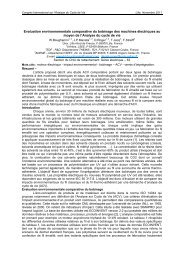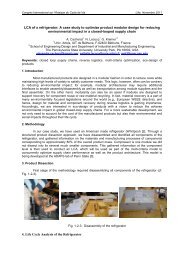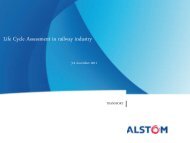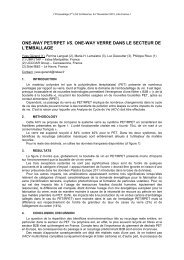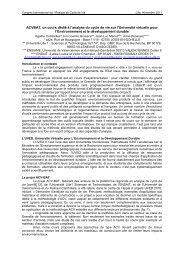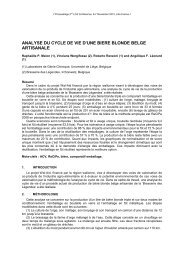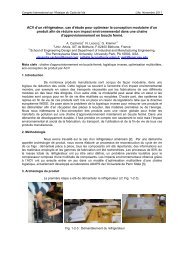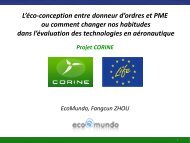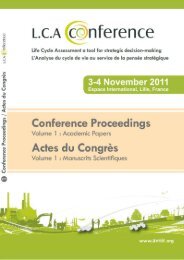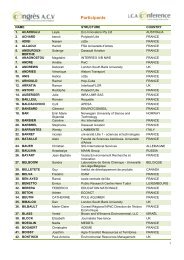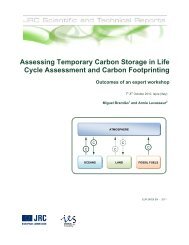Congrès International sur l'Analyse du Cycle de Vie Lille ... - avniR
Congrès International sur l'Analyse du Cycle de Vie Lille ... - avniR
Congrès International sur l'Analyse du Cycle de Vie Lille ... - avniR
Create successful ePaper yourself
Turn your PDF publications into a flip-book with our unique Google optimized e-Paper software.
Congrès <strong>International</strong> <strong>sur</strong> l’Analyse <strong>du</strong> <strong>Cycle</strong> <strong>de</strong> <strong>Vie</strong> <strong>Lille</strong>, Novembre 2011<br />
Pro<strong>du</strong>ct and carbon footprinting labelling: lessons from footprinting<br />
1000 pro<strong>du</strong>cts in Tesco’s supply chain<br />
Paul-Antoine BONTINCK, Consultant ACV, Environmental resources<br />
management (ERM)<br />
A 2007 study shows that for every seven pounds of food pro<strong>du</strong>ced, one goes to Tesco. Tesco<br />
therefore has a huge potential to improve their footprint. We assessed their direct footprint, supply<br />
chain and customer footprint, to help them set objectives for 2020. They want to halve their impact<br />
and re<strong>du</strong>ce emissions by 30%. One step taken to do so is environmental labelling, which shows a<br />
pro<strong>du</strong>ct’s and waste‘s footprint.<br />
We analysed 60 varieties of Tesco-sold potatoes, looking for primary data (growing, processing,<br />
packaging, transport, distribution centres, consumer use). The certification process can take 2-4<br />
weeks but data collection is important. In addition to the primary data collection, we sent a<br />
questionnaire to a representative sample of Tesco’s potato suppliers about their farming practices.<br />
Crop pro<strong>du</strong>ction (irrigation energy, fertilizer, storage) and consumer use (waste, cooking method)<br />
were found to have the most impact. This gave Tesco the baseline to set targets, improve their water<br />
footprint and increase the efficiency of their on-site renewable energy. Furthermore, they are<br />
currently working on improving their farming practices since synthetic fertilizer also has a huge<br />
impact. Lastly, they are also holding conferences to disseminate their learnings.<br />
To be labelled, pro<strong>du</strong>cts must be certified. As with any full LCAs, this involves peer review. By<br />
performing pro<strong>du</strong>ct-level LCAs, I think we have shown the limits of mass-pro<strong>du</strong>ced carbon footprints.<br />
Tesco must move away from mass-pro<strong>du</strong>ced items. The next step for Tesco is working in-house on<br />
adapting their methods to re<strong>du</strong>ce their footprint and do more work at a lower cost.<br />
L’empreinte eau : applications dans le secteur <strong>de</strong> l’agroalimentaire<br />
Jean-Baptiste BAYART, Ingénieur <strong>de</strong> recherche, Veolia environnement,<br />
recherche et innovation<br />
L’impact <strong>de</strong> l’activité humaine <strong>sur</strong> les ressources en eau représente un enjeu croissant dans l’agenda<br />
environnemental. Les recherches « Empreinte eau » cherchent à le quantifier et le comprendre.<br />
L’eau est prise en compte par l’Analyse <strong>du</strong> cycle <strong>de</strong> vie (ACV) <strong>de</strong>puis 2006. L’inventaire <strong>de</strong>s flux<br />
(consommés ou émis dans le cycle <strong>de</strong> vie d’un pro<strong>du</strong>it) est tra<strong>du</strong>it en indicateurs d’impact <strong>sur</strong><br />
l’environnement plus ou moins agrégés : la pollution <strong>de</strong> l’eau est ainsi me<strong>sur</strong>ée par son eutrophisation<br />
ou sa toxicité aquatique. En tant que ressource, l’eau consommée est facilement comptabilisable, au<br />
contraire <strong>de</strong> sa contribution à un impact environnemental ou <strong>de</strong> sa restitution à l’environnement.<br />
L’empreinte eau <strong>de</strong>s différents pro<strong>du</strong>its est évaluée en mètres cubes, un indicateur commo<strong>de</strong>, mais<br />
grossier. Par exemple, la culture <strong>de</strong>s arachi<strong>de</strong>s nécessite six fois plus d'eau que celle <strong>de</strong>s tomates,<br />
mais une fois l’empreinte eau <strong>de</strong> ces pro<strong>du</strong>its pondérée par le stress hydrique local, les tomates<br />
contribuent dix fois plus à l'épuisement <strong>de</strong>s ressources en eau, car les arachi<strong>de</strong>s sont pro<strong>du</strong>ites dans<br />
<strong>de</strong>s régions à irrigation pluviale. Une norme ISO <strong>sur</strong> l’empreinte eau est en préparation et se fon<strong>de</strong><br />
<strong>sur</strong> cette idée <strong>de</strong> spatialisation.<br />
Plusieurs méthodologies d’intégration <strong>de</strong> l’empreinte eau dans l’ACV sont dévelop pées, et répon<strong>de</strong>nt<br />
à <strong>de</strong>s objectifs différents. Veolia a ainsi mis au point un indicateur pragmatique : le Water impact<br />
in<strong>de</strong>x. Il me<strong>sur</strong>e la ré<strong>du</strong>ction <strong>de</strong> la disponibilité <strong>de</strong>s ressources en eau générée par une activité<br />
humaine. Cet indicateur calcule le volume d’eau nécessaire à la pro<strong>du</strong>ction d’un pro<strong>du</strong>it, pondéré par<br />
un indice <strong>de</strong> stress hydrique local et <strong>de</strong> qualité <strong>de</strong> l’eau.<br />
Le Water impact in<strong>de</strong>x a été appliqué à la gestion <strong>de</strong> l’eau d’un site in<strong>du</strong>striel alimentaire. Chaque<br />
étape <strong>du</strong> process consomme <strong>de</strong> l’eau traitée chimiquement et énergétiquement, et pro<strong>du</strong>it <strong>de</strong>s boues.



